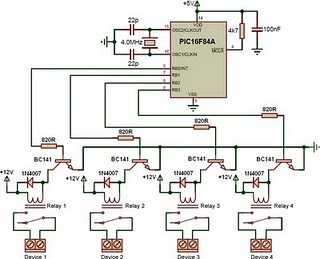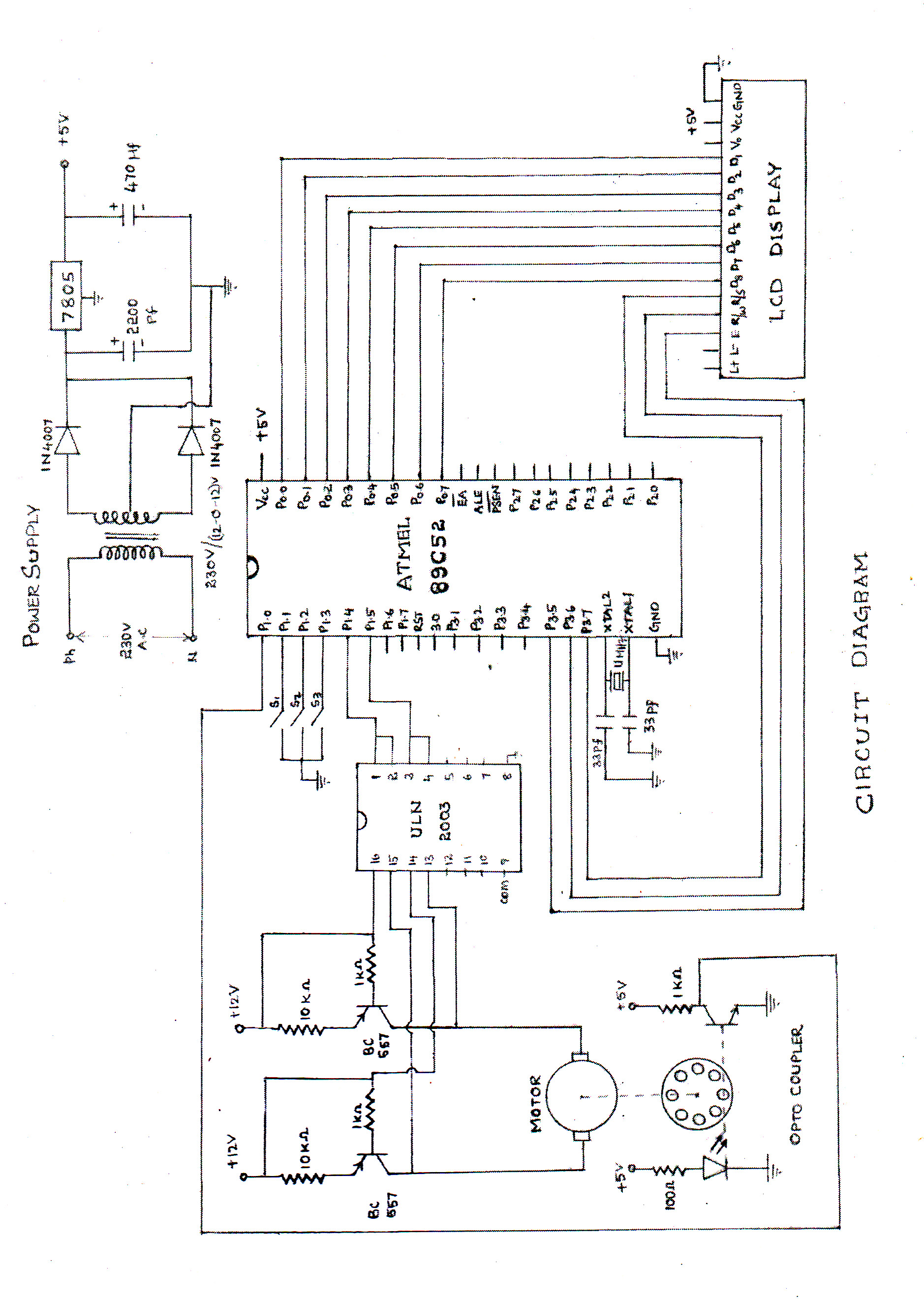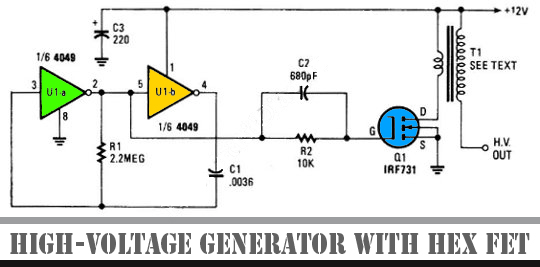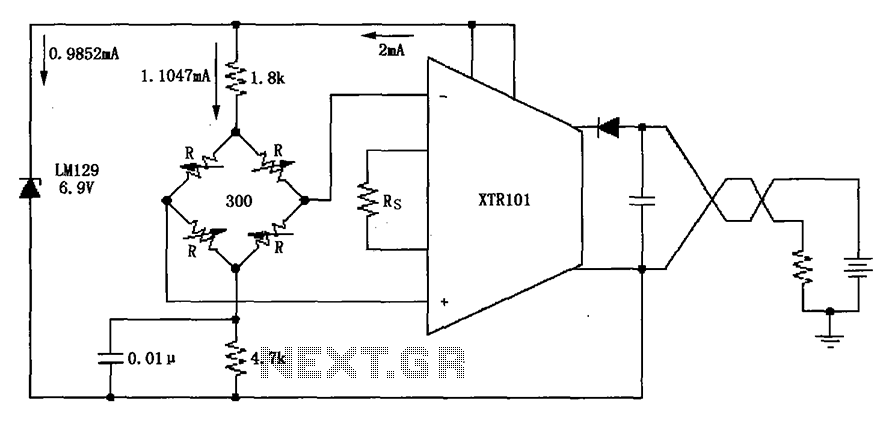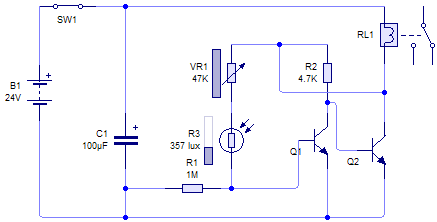
Voltage Levels Control Relays
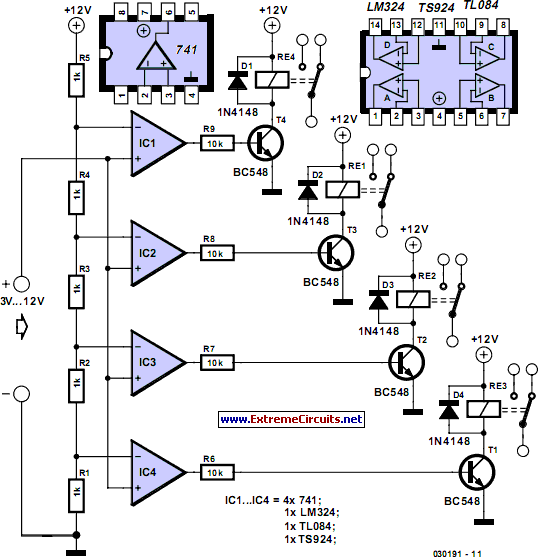
This circuit demonstrates that microprocessors, PCs, and modern ultra-accurate Digital-to-Analog Converters (DACs) are excessive for controlling four relays in sequence based on a control voltage ranging from 2.4 V to 12 V. By utilizing equal resistors in a ladder network (R1-R5), equal voltage intervals are established to activate the relays sequentially. Each resistor drops 1/5th of the supply voltage, which in this case is 2.4 V, resulting in voltage levels of +2.4 V for relay Re1, +4.8 V for relay Re2, +7.2 V for relay Re3, and +9.6 V for relay Re4. These switching levels will vary with the supply voltage, necessitating a stabilized power supply. At the lowest switching level, when the control voltage exceeds 2.4 V, IC1 will change its output to nearly the supply level. The current directed to the base of transistor T1 is limited to approximately 1 mA by resistor R6. With T1 fully driven, relay Re1 is activated by the collector current. Given that the BC548 transistor has a maximum collector current specification of 100 mA, the relay coil resistance should not be less than 120 ohms. The majority of the current consumed by the circuit is due to the relay coils, thus a robust power supply capable of delivering up to 500 mA may be necessary. When designing the ladder network for the desired switching levels, it is important to note that the 741 operational amplifier does not function well with input voltages below 1.5 V or above 10.5 V, and voltages outside the supply range (negative or exceeding +12 V) are inadmissible. For switching levels in the range of 0-1.5 V, an LM324, which contains four operational amplifiers in one package, is recommended. For the upper range (10.5 to 12 V), a TL084 or a rail-to-rail operational amplifier like the TS924 is required, although the TS924 cannot be used with supply voltages exceeding 12 V.
This circuit effectively utilizes a resistor ladder network to create a series of defined voltage levels that correspond to the sequential activation of relays. The use of equal-value resistors ensures that the voltage drop across each resistor is uniform, facilitating predictable relay activation at specified control voltages. The choice of a stabilized power supply is crucial to maintain consistent relay operation, particularly as variations in supply voltage could lead to unintended relay behavior.
The circuit employs a BC548 transistor to drive the first relay, which is suitable for applications where the relay's coil resistance is maintained above the specified threshold. The design considerations for the operational amplifier (op-amp) are critical; the 741 op-amp's limitations necessitate careful selection of input voltage ranges to ensure reliable operation. For applications requiring lower voltage switching, the LM324 offers a versatile alternative, while the TS924 provides enhanced performance for higher voltage applications, albeit with its own constraints.
Overall, this circuit is an efficient solution for controlling multiple relays with minimal complexity, eliminating the need for more advanced microprocessor-based systems in scenarios where such sophistication is unwarranted. The design's simplicity, combined with the use of readily available components, makes it an attractive option for various electronic control applications.This circuit proves that microcoprocessors, PCs and the latest ultra-accurate DACs are overkill when it comes to controlling four relays in sequence in response to arising control voltage in the range 2. 4 V 12 V. By using equal resistors in ladder network R1-R5, equal intervals are created between the voltages that switch on the relays in seque
nce. Each resistors drops 1/5th of the supply voltage or 2. 4 V in this case, so we get +2. 4 V = Re1, +4. 8 V = Re2, +7. 2 V = Re3, +9. 6 V = Re4. Obviously, these switching levels vary along with the supply voltage, hence the need to employ a stabilised power supply. Looking at the lowest level switching stage, when the control voltage exceeds 2. 4 V, IC1 will flip its output to (nearly) the supply level. The resulting current sent into the base of T1 is limited to about 1 mA by R6. With T1 driven hard, relay Re1 is energised by the collector current. Because the BC548 has a maximum collector current spec of 100 mA, the relay coil resistance must not be smaller than 120 ohms.
Nearly all current consumed by the circuit goes on account of the relay coils, so depending on your relays a pretty hefty power supply of up to 500 mA may be required. When dimensioning the ladder network to create the desired switching levels, it is good to remember that the 741 will not operate very well with input voltages below 1.
5 V or above 10. 5 V, while voltage levels outside the supply range (i. e. , negative or above +12 V) are out of the question. If you do need a switching level in the range 0-1. 5 V, consider using an LM324, which contains four opamps in one package. For the high side of the range (10. 5 to 12 V), a TL084 or a rail-to-rail` opamp like the TS924 is required. However, the TS924 cannot be used with supply voltages above 12 V. Be the first of your friends to get free diy electronics projects, circuits diagrams, hacks, mods, gadgets & gizmo automatically each time we publish. Your email address & privacy are safe with us ! 🔗 External reference
This circuit effectively utilizes a resistor ladder network to create a series of defined voltage levels that correspond to the sequential activation of relays. The use of equal-value resistors ensures that the voltage drop across each resistor is uniform, facilitating predictable relay activation at specified control voltages. The choice of a stabilized power supply is crucial to maintain consistent relay operation, particularly as variations in supply voltage could lead to unintended relay behavior.
The circuit employs a BC548 transistor to drive the first relay, which is suitable for applications where the relay's coil resistance is maintained above the specified threshold. The design considerations for the operational amplifier (op-amp) are critical; the 741 op-amp's limitations necessitate careful selection of input voltage ranges to ensure reliable operation. For applications requiring lower voltage switching, the LM324 offers a versatile alternative, while the TS924 provides enhanced performance for higher voltage applications, albeit with its own constraints.
Overall, this circuit is an efficient solution for controlling multiple relays with minimal complexity, eliminating the need for more advanced microprocessor-based systems in scenarios where such sophistication is unwarranted. The design's simplicity, combined with the use of readily available components, makes it an attractive option for various electronic control applications.This circuit proves that microcoprocessors, PCs and the latest ultra-accurate DACs are overkill when it comes to controlling four relays in sequence in response to arising control voltage in the range 2. 4 V 12 V. By using equal resistors in ladder network R1-R5, equal intervals are created between the voltages that switch on the relays in seque
nce. Each resistors drops 1/5th of the supply voltage or 2. 4 V in this case, so we get +2. 4 V = Re1, +4. 8 V = Re2, +7. 2 V = Re3, +9. 6 V = Re4. Obviously, these switching levels vary along with the supply voltage, hence the need to employ a stabilised power supply. Looking at the lowest level switching stage, when the control voltage exceeds 2. 4 V, IC1 will flip its output to (nearly) the supply level. The resulting current sent into the base of T1 is limited to about 1 mA by R6. With T1 driven hard, relay Re1 is energised by the collector current. Because the BC548 has a maximum collector current spec of 100 mA, the relay coil resistance must not be smaller than 120 ohms.
Nearly all current consumed by the circuit goes on account of the relay coils, so depending on your relays a pretty hefty power supply of up to 500 mA may be required. When dimensioning the ladder network to create the desired switching levels, it is good to remember that the 741 will not operate very well with input voltages below 1.
5 V or above 10. 5 V, while voltage levels outside the supply range (i. e. , negative or above +12 V) are out of the question. If you do need a switching level in the range 0-1. 5 V, consider using an LM324, which contains four opamps in one package. For the high side of the range (10. 5 to 12 V), a TL084 or a rail-to-rail` opamp like the TS924 is required. However, the TS924 cannot be used with supply voltages above 12 V. Be the first of your friends to get free diy electronics projects, circuits diagrams, hacks, mods, gadgets & gizmo automatically each time we publish. Your email address & privacy are safe with us ! 🔗 External reference
